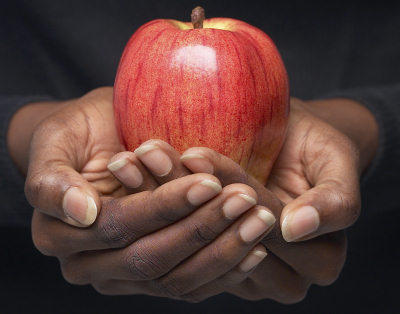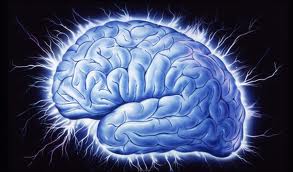
Brain Food
1. Shellfish: Shellfish contains Vitamin B12, iron, magnesium and potassium which are great for brain function.
2. Low-fat foods: Psychology Today reports that a diet rich in saturated fatty foods can lead to depression and cancer.
3. Salmon: Salmon is full of omega-3 fatty acids, which are good for the heart and brain.
4. Canola oil: Cook with canola oil instead of corn and sunflower oils to up your intake of omega-3s.
5. Avocado: Avocado is full of the good kinds of fatty acids, and it’s also supposed to be good for your hair and nails.
6. Good carbohydrates: To keep your glucose levels at the right level, eat vitamin-rich, whole grain cereals, toast and crackers when your energy is low.
7. Eggs: Eggs contain choline, a type of B vitamin that is good for memory and stress management.
8. Almonds: Almonds are often touted as a good brain food, giving you lots of energy. They also contain choline.
9. Fruits and vegetables: Fruits and vegetables have many great health benefits, and the brain especially loves green, leafy veggies.
10. Lean beef: Lean beef and beef liver also contain choline.
Bone Health
1. Fortified milk: Make sure the milk you’re drinking is fortified with Vitamin D.
2. Kale: Kale is rich in Vitamin K and contains calcium.
3. Cottage cheese: Cottage cheese is estimated to have between 318 and 156 mg of calcium.
4. Fortified orange juice: Fortified oj is also a great source of Vitamin D.
5. Cabbage: Cabbage raises estrogen levels, which is good for aging women.
6. Calcium-fortified cereal: WebMD suggests having 1 cup of calcium-fortified cereal for a bone-healthy breakfast.
7. Calcium-fortified soy milk: If you’re lactose intolerant, try soy milk, which contains between 80 and 500 mg of calcium if it’s fortified.
8. Collards: Just 1/2 a cup of collards contains about 20% of your recommended daily value of calcium.
9. Dandelion: Add dandelion to your recipes to get heaping doses of boron and a good share of calcium.
10. Yogurt: One cup of yogurt contains between 300 and 400 mg of calcium.
Dental Health
1. Raisins: ScienceDaily reports that the “compounds found in raisins fight bacteria in the mouth that cause cavities and gum disease.”
2. Water: Water is essential to good oral health.
3. Raw broccoli: Raw broccoli is rich in magnesium, which teeth love.
4. Cooked spinach: Cooked spinach is another good source of magnesium.
Avoiding Empty Calories
1. Peanut butter: In moderation, peanut butter is a good snack because it lower cholesterol and your risk for cardiovascular disease. Peanut butter also keeps you full longer, so you won’t keep reaching for more snacks.
2. Dark chocolate: “Dark chocolate is healthy chocolate,” according to WebMD, and in small servings, it’s a great alternative to heavier desserts.
3. Milk: Milk has calcium and Vitamin D, and it’s also good for weight loss.
4. Nuts: Unsalted nuts are a great snack, and even though they may have a higher calorie content than a few potato chips, they’ll keep you full longer and will give you much needed nutrients.
5. Banana: Eat a banana for a snack or for dessert instead of a piece of cake that’s packed with nothing but sugar and has no nutrients. Bananas are also softer fruits, which can be ideal for some people with dentures or weaker teeth.
6. Fiber-rich foods: Foods with a lot of fiber will keep you fuller longer and are better for your digestion.
Antioxidants
1. Carrots: Carrots are rich in beta-carotene, which is an antioxidant. Steam carrots if raw ones are too crunchy.
2. Spinach: Raw and cooked spinach are both good sources of lutein.
3. Sweet potatoes: Sweet potatoes are soft and have lots of beta-carotene and Vitamin A. Be careful of extra sugary yams, however.
4. Tomatoes: Eat tomatoes to get the antioxidant lycopene.
5. Blueberries: Blueberries are considered good brain food and are rich in antioxidants.
Low-Sugar
1. Diet, caffeine-free soda: If you’re a soda-oholic, try a diet, caffeine-free version. Water is best, though.
2. Whole grain breads: Multigrain, whole grain and mixed grain breads have a lower glycemic index than most other breads.
3. Apples: If your teeth are strong enough, cut up some apple, which has a lower glycemic index than oranges, peaches and bananas.
4. Low-fat yogurt: Instead of ice cream, have some low-fat yogurt for a snack, which has a glycemic index of 33.
5. Vegetables: Snack on fresh veggies for sugar-free and low-sugar snacks.
Digestion and More
1. Red beets: Red beets are said to help constipation symptoms.
2. Non-greasy foods: Greasy foods are harder to digest and can give more sensitive tracts heartburn and discomfort.
3. Cranberry juice: Drink 100% cranberry juice (not cranberry juice concentrate) to ward off urinary tract infections.
4. Cod liver oil: Rich in Vitamin A and Vitamin D, cod liver oil is also good for the digestive tract.
5. Green tea: Some believe that green tea helps ease Inflammatory Bowel Disease, and it’s also good for the heart.
6. Raw foods: Raw and unprocessed foods are best for warding off colon cancer.
7. Barley: Soluble fiber, which does not create excess gas, is found in barley.
8. Prunes: Prunes are an excellent source of dietary fiber, which helps digestion and bowel movements.
9. Oat bran: Oat bran is another source of soluble fiber.
10. Turnips: Include turnips in your meals to get even more dietary fiber.
Low-Salt
1. Lima beans: A 3.5 oz. serving of canned lima benas only have 1 mg of sodium.
2. Brussel sprouts: Enjoy brussel sprouts at just 10 mg of sodium per 3.5 oz. serving.
3. Fresh coconut: Fresh coconut has a moderate amount of salt but is a good snack alternative to chips.
4. Blackberries: Blackberries just have 1 mg of sodium per 3.5 oz. serving.
5. Roast beef: Roast beef without extra sauces only has 60 mg of salt per 3.5 oz. serving.
6. White bean and roasted bell pepper hummus: This low sodium recipe is recommended by the American Heart Association.
7. Colorful Tuna Pasta Salad: This entire meal has 320 mg of sodium per 1 1/2 cup serving.
8. Okra and Tomatoes: This hot veggie dish is still low sodium.
9. Apple sauce: If sodium is a major issue for you, make or buy a low-sodium apple sauce to snack on.
10. Herring: Herring can be a low-sodium dinner alternative.
Whole Grains
1. Whole grain cereal: Whole grain cereal is an easy breakfast or snack option that provides lots of fiber and vitamins.
2. Whole wheat pasta: Your body can break down whole wheat pasta better than white pasta.
3. Whole grain sandwich bread: Whole grain bread is not made up of refined carbohydrates, which are harder to digest and pack on pounds.
4. Whole wheat tortillas: Whole wheat tortillas are better for you than flour or fried versions.
5. Whole wheat flour: Look for whole wheat flour when comparing nutrition labels.
6. Whole grain or wheat English muffins: You don’t have to give up your English muffins if you’re afraid of starches and refined sugar and carbohydrates. Just pick a whole grain or whole wheat version instead.
7. Bulgur: Bulgur is a cracked wheat ingredient that satisfies a whole grains servings requirement.
8. Brown rice: Brown rice is good for you and will keep you full longer, so you’re getting the most out of your calorie intake.
9. Quinoa: If you’re tired of rice, make quinoa for another whole grain side dish.
10. Bran: Bran cereals or granola bars are good for digestion and for keeping you full.
Fruits and Veggies
At all ages, raw fruits and vegetables or lightly steamed vegetables are the best choice for getting the most vitamins and minerals per bite. Read below for some of our suggestions.
1. Kiwi: Kiwi is one of the few fruits that contains riboflavin, which helps release energy from carbs.
2. Peas: Peas are another food that can help your body get energy from carbohydrates more easily. Raw peas work well in salads.
3. Mushrooms: Mushrooms are an excellent low-calorie food that have more potassium than oranges, can lower blood pressure and may decrease tumor size.
4. Asparagus: Asparagus is a great source of Vitamin A, which helps cell reproduction and is good for the immune system.
5. Corn: Cook with fresh corn to get enough Vitamin B3, or niacin, which is good for the digestive system.
6. Cauliflower: Eat cauliflower for a faster metabolism, which slows as you get older.
7. Watermelon: Watermelon has a lot of sugar, but it’s low in calories and contains B6, B3, B1, and Vitamin A. Enjoy in small samples.
8. Summer squash: Summer squash is easy to prepare and works well with all kinds of dishes. It’s also a good source of niacin.
9. Strawberries: Strawberries have antioxidant benefits and Vitamin C.
10. Cucumber: Add cucumber to your salads for an extra dose of Vitamin C.
11. Peppers: Peppers are another easy and versatile vegetable, and they are an excellent source of Vitamin A, beta-carotene and Vitamin C. They also contain potassium and iron.
12. Artichokes: Artichokes are another source of niacin.
13. Red cabbage: Good for stews and soups, red cabbage contains iron, Vitamin A and lots of Vitamin C.
14. Brown onion: Add brown onion to your meals for a good source of Vitamins B1, B6 and C.
15. Leeks: Eat leeks to get a good serving of folate.
Vitamins, high-nutrient foods
1. Calcium: Healthlink, The Medical College of Wisconsin reports that seniors need between 1200 and 1400 mg of calcium daily.
2. Vitamin D: Seniors need 600 international units of Vitamin D, according to Healthlink.
3. Antioxidant vitamins: If you don’t get enough of the right vegetables and fruits that have antioxidants, take a supplement.
4. Fiber: Fiber helps digestion and prevents diverticulosis.
5. Vitamin C: Vitamin C supplements are easy to find and can help boost your immune system.
6. B12: If your breakfast cereal and milk is not fortified with B12, take a supplement.
7. Vitamin K: Vitamin K helps prevent blood clotting and keeps bones strong, and it may even help prevent Alzheimer’s.
8. Zinc: Zinc is considered to be an antioxidant but isn’t found in large amounts in enough foods.
9. Bioflavonoids: Give your immune system more power by taking a bioflavonoid supplement.
10. Folate: Harvard School of Public Health reports that folate may prevent some types of cancer and heart disease.
Eyesight
1. Garlic: Garlic contains a lot of sulfur, which produces a kind of antioxidant for the eye called glutathione.
2. Lutein: Foods with lutein, like kale and spinach, are good for eyesight.
3. Onions: Onions are also rich in glutathione.
4. Low sugar foods: The American Journal of Clinical Nutrition found that high sugar diets and foods might make AMD, or age-related macular degeneration, worse.
5. Fish Oil: Fish oil found in mackerel, salmon, flax seed and walnuts, help preserve eyesight.
Tags: anti-oxidants, bone health, brain, brain food, brain function, dental health, digestion, eyesight, health, science, self-help







